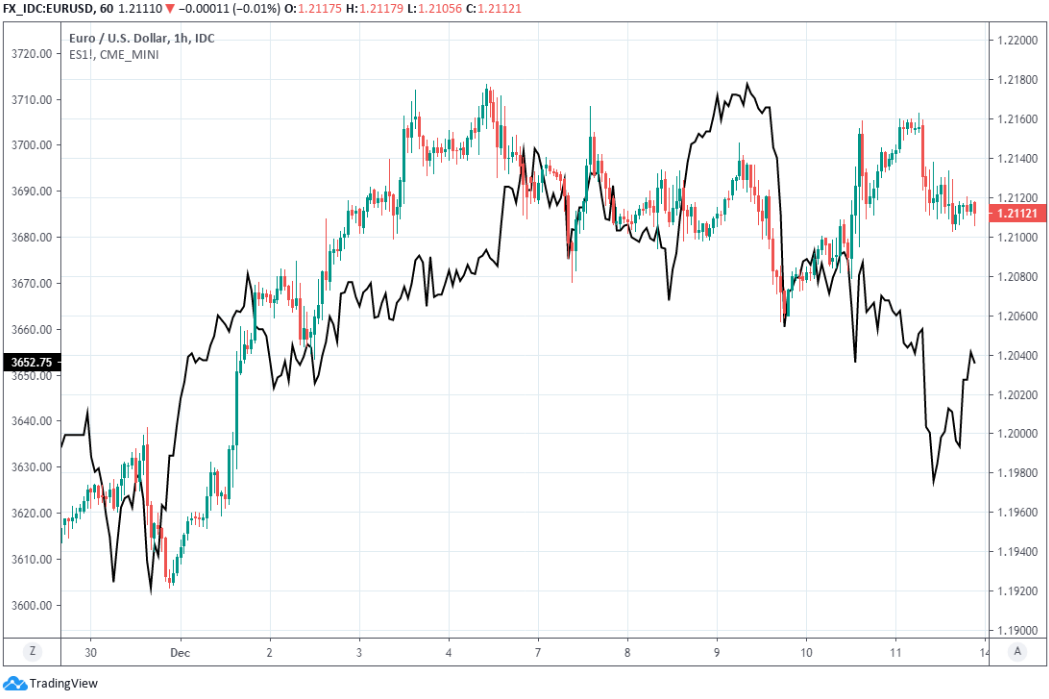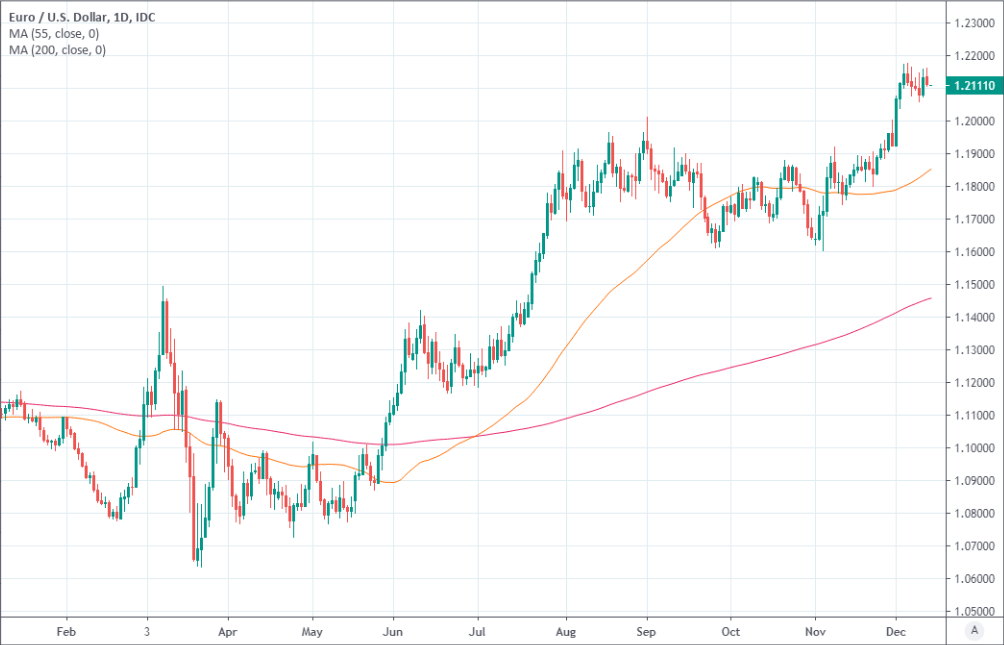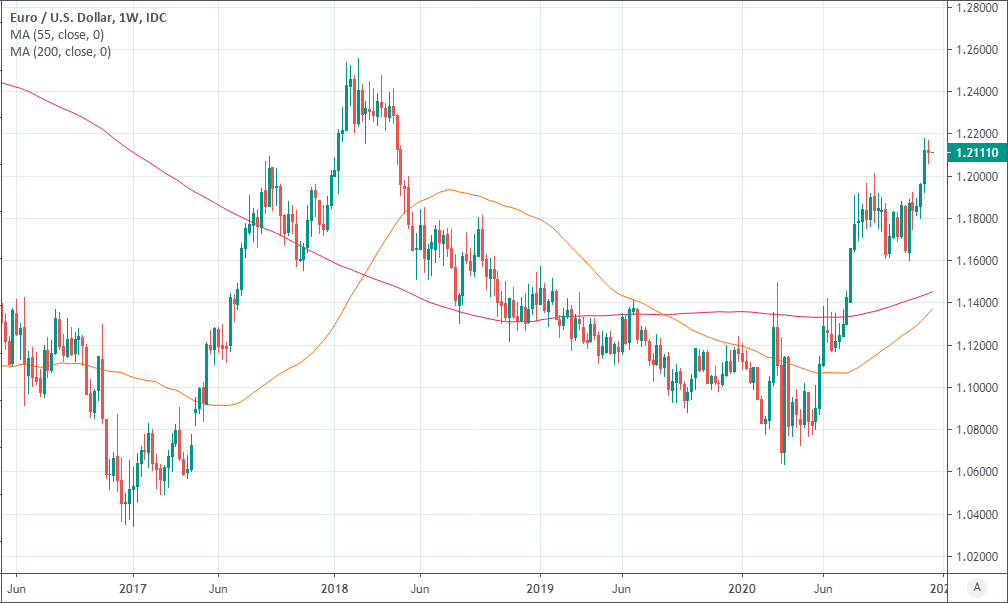Euro-Dollar Week Ahead Forecast: Eyeing New Highs as Political Risks Ebb and Vaccine Optimism Grows
- Written by: James Skinner
-
- EUR/USD dodges wave of policy flak, still supported above 1.20.
- German restrictions, lingering Brexit risk short-term headwinds.
- But vaccine progress & EU budget deal to support risk appetite.
- Technical, fundamental analysts eyeing 1.25 post ECB decision.

Image © Adobe Images
- EUR/USD spot rate at time of writing: 1.2112
- Bank transfer rate (indicative guide): 1.1652-1.1748
- FX specialist providers (indicative guide): 1.1940-1.2005
- More information on FX specialist rates here
The Euro-to-Dollar exchange rate enters the new week with fundamental and technical analysts tipping an advance toward new 2020 highs after the single currency successfully navigated a wave of political and policy flak.
Europe's single currency stalled before closing lower by a fraction for the period last week as multiple political pollutants fogged the atmosphere around European currencies that were previously trading at lofty heights.
The Euro was -0.12% for the week but only after Thursday's post-European Central Bank (ECB) lifted it back from beneath the 1.21 handle when Europe's monetary policymakers opted not to go nuclear on strengthening exchange rates by cutting their main interest rate further below zero.
Instead policymakers delivered the €500bn extension to the ECB's quantitative easing programme that was anticipated by markets and said little about recent moves on the currency market, in an update that's been perceived in some parts as a green light for a further increase in the Euro-to-Dollar rate.
"We remain EM bullish and find that the ECB has paved the way for 1.25 levels in EUR/USD," says Andreas Steno Larsen, chief FX strategist at Nordea Markets. "ECB QE was PEPPed up without any real threat of rate cuts (good news for EUR bulls), the two parties in the Brexit negotiations now hold a no deal as base case (time to buy GBP again?) and EM bets keep performing in an anticipation of a marvellous 2021. We have talked over and over about the potential melt-up in risk assets in 2021 due to too much money chasing too few assets post the pandemic. It arguably feels like we are already in 2021."
The ECB decision to keep its powder dry and go quiet about currency strength removed an obstacle from the path ahead, although the Euro could be heartened on Monday by European Commission chief Ursula Von Der Leyen and British Prime Minister Boris Johnson having agreed to continue efforts to reach a trade deal rather than call them off as had been planned on Friday. 
Above: Euro-to-Dollar at hourly intervals with 55, 200-period (red) moving-averages and S&P 500 index futures (black line).
"Were it not for Brexit, we think EUR/USD would be trading 1.23 by now. Presumably, GBP will be dragging EUR around by the nose on Monday morning, driven by any progress – or lack thereof – on Brexit discussions. But given: a) the powerful dollar bear trend and b) EU leaders having approved the 2021-27 budget and Recovery Fund and c) the ECB meeting having passed, we believe EUR/USD should stay supported," says Petr Krpata, chief EMEA strategist for currencies and interest rates at ING. "Away from fiscal and monetary decisions in Washington and the Brexit deliberations in Brussels, the Eurozone calendar is relatively light this week."
Britain and Europe will be busy with a soap opera Monday, enabling investors to dedicate their energies to celebration of the Food & Drug Administration decision decision after the market close on Friday to approve for emergency use, the coronavirus vaccine made by Pfizer and Germany's BioNTech
The world's largest economy follows Britain next week in making the vaccine available to some of its most vulnerable and is hoping to have some 100 million people vaccinated by the end of March, almost a third of the population, while pressure is rising on European regulators to follow suit.
{wbamp-hide start} {wbamp-hide end}{wbamp-show start}{wbamp-show end}
Vaccine developments put light at the end of the tunnel for a continent where the economy's recovery from earlier draconian 'lockdown' was scuppered this quarter by renewed restrictions on activity, which have sought in vain to curb the spread of the sometimes-pneumonia inducing disease. They could also lift investor risk appetite early in the new week and along with it, the Euro, which also enjoys a supportive backdrop on the charts.
"EUR/USD remains in consolidation mode very near term but this is regarded in a bullish light...Targets are the 1.2556 2018 high and 1.2622, the 200 month moving average. This remains our longer term target," says Karen Jones, head of technical analysis for currencies, commodities and bonds at Commerzbank. "Dips should find initial support at 1.2012 (nearby uptrend) and good nearby support at the 1.1782/1.1837 November 23 low, the 55 day ma."
Vaccine-related optimism and political wins for Brussels in relation to Brexit as well as its coronavirus recovery fund and next seven-year budget could enable the Euro to overlook on Monday the negative implications for the final-quarter growth outlook stemming from Germany's weekend decision to tighten up its coronavirus restrictions ahead of the festive break. German leaders ordered supposedly non-essential shops as well as schools to close again from Wednesday amid a quickening spread of the infection.
Above: Euro-to-Dollar rate shown at daily intervals with 55 and 200-period (red) moving-averages.
Schools were already due to shut as a result of the festive holidays while restaurants and bars had already closed their doors too, although the pending shutdown of Germany's remaining high street businesses has still prompted a downward revision to growth forecasts for Europe's largest economy.
"Due to the looming restrictions, we have adjusted the time profile of our GDP forecasts to show a sharper contraction in late 2020 offset by a faster snapback in Q2 2021 when we expect life to return to much more normal. Warmer and sunnier weather and vaccination programmes should help to contain the pandemic more decisively by April at the latest," says Holger Schmieding, chief economist at Berenberg. "First substantial payments from the corona recovery fund will likely flow to member states on schedule, that is roughly by June 2021. With some noise, the EU got its act together. Let us hope that US policy makers follow suit and resolve their own fiscal disputes fast."
Growth forecasts are falling as a vaccine rollout draws closer for Europe, which will also now benefit from the EU's earlier agreed €750bn recovery fund, with payments set to flow from the budget to hard up member states as soon as June 2021. This was after German Chancellor Angela Merkel reached a compromise agreement with Hungary and Poland that paved the way for them to abandon earlier threats to veto both the budget and recovery fund. The two countries had objections to new terms for accessing EU monies.
Previously the bloc faced a crisis from January onward, one where Brussels would be forced to rely on monthly budgets set according to earlier policy priorities. But with the spat resolved and tensions reduced, political risk in Europe now consists of little more than a Brexit saga that could culminate with a deal as soon as this month, leaving little to clip the Euro's wings.
"Threatening to torpedo the EU’s finances by vetoing its budget was a desperate gamble on Orbán’s part. But it was a bluff that should have been called. Unfortunately, Merkel has, it appears, caved in to Hungarian and Polish extortion. As I write, it seems clear that Merkel has brokered a compromise with Orbán and Poland’s de facto leader, Deputy Prime Minister Jarosław Kaczyński. The deal that Germany made with the EU’s two rogue member states, however, constitutes the worst of all possible worlds," writes George Soros, a veteran financier, philanthropist and friend of the EU, in an article for Project Syndicate. "The proposed summit declaration is a case of the European Council acting beyond its authority in constraining the European Commission’s ability to interpret and act on agreed EU legislation. That is a dangerous precedent, because it reduces the Commission’s legal independence and may very well contravene the Treaty on European Union, at least in spirit.
Above: Euro-to-Dollar rate shown at weekly intervals with 55 and 200-period (red) moving-averages.






